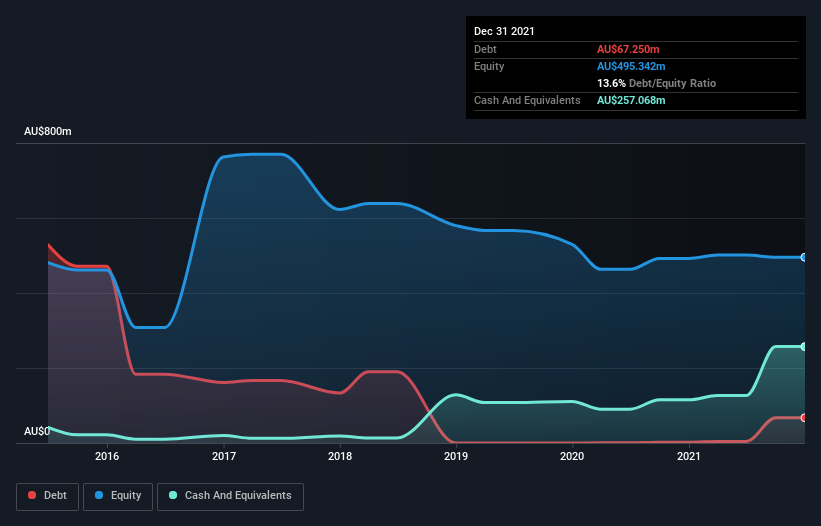Here's Why HT&E (ASX:HT1) Can Manage Its Debt Responsibly
Legendary fund manager Li Lu (who Charlie Munger backed) once said, 'The biggest investment risk is not the volatility of prices, but whether you will suffer a permanent loss of capital.' It's only natural to consider a company's balance sheet when you examine how risky it is, since debt is often involved when a business collapses. We note that HT&E Limited (ASX:HT1) does have debt on its balance sheet. But is this debt a concern to shareholders?
When Is Debt A Problem?
Debt assists a business until the business has trouble paying it off, either with new capital or with free cash flow. If things get really bad, the lenders can take control of the business. However, a more frequent (but still costly) occurrence is where a company must issue shares at bargain-basement prices, permanently diluting shareholders, just to shore up its balance sheet. Of course, the upside of debt is that it often represents cheap capital, especially when it replaces dilution in a company with the ability to reinvest at high rates of return. When we examine debt levels, we first consider both cash and debt levels, together.
See our latest analysis for HT&E
What Is HT&E's Net Debt?
The image below, which you can click on for greater detail, shows that at December 2021 HT&E had debt of AU$67.3m, up from AU$1.82m in one year. However, its balance sheet shows it holds AU$257.1m in cash, so it actually has AU$189.8m net cash.
How Healthy Is HT&E's Balance Sheet?
We can see from the most recent balance sheet that HT&E had liabilities of AU$83.6m falling due within a year, and liabilities of AU$204.6m due beyond that. Offsetting these obligations, it had cash of AU$257.1m as well as receivables valued at AU$51.4m due within 12 months. So it can boast AU$20.2m more liquid assets than total liabilities.
This surplus suggests that HT&E has a conservative balance sheet, and could probably eliminate its debt without much difficulty. Simply put, the fact that HT&E has more cash than debt is arguably a good indication that it can manage its debt safely.
Notably HT&E's EBIT was pretty flat over the last year. Ideally it can diminish its debt load by kick-starting earnings growth. When analysing debt levels, the balance sheet is the obvious place to start. But it is future earnings, more than anything, that will determine HT&E's ability to maintain a healthy balance sheet going forward. So if you want to see what the professionals think, you might find this free report on analyst profit forecasts to be interesting.
Finally, a business needs free cash flow to pay off debt; accounting profits just don't cut it. While HT&E has net cash on its balance sheet, it's still worth taking a look at its ability to convert earnings before interest and tax (EBIT) to free cash flow, to help us understand how quickly it is building (or eroding) that cash balance. Happily for any shareholders, HT&E actually produced more free cash flow than EBIT over the last three years. That sort of strong cash conversion gets us as excited as the crowd when the beat drops at a Daft Punk concert.
Summing up
While it is always sensible to investigate a company's debt, in this case HT&E has AU$189.8m in net cash and a decent-looking balance sheet. And it impressed us with free cash flow of AU$35m, being 134% of its EBIT. So we don't have any problem with HT&E's use of debt. The balance sheet is clearly the area to focus on when you are analysing debt. But ultimately, every company can contain risks that exist outside of the balance sheet. These risks can be hard to spot. Every company has them, and we've spotted 3 warning signs for HT&E you should know about.
When all is said and done, sometimes its easier to focus on companies that don't even need debt. Readers can access a list of growth stocks with zero net debt 100% free, right now.
Have feedback on this article? Concerned about the content? Get in touch with us directly. Alternatively, email editorial-team (at) simplywallst.com.
This article by Simply Wall St is general in nature. We provide commentary based on historical data and analyst forecasts only using an unbiased methodology and our articles are not intended to be financial advice. It does not constitute a recommendation to buy or sell any stock, and does not take account of your objectives, or your financial situation. We aim to bring you long-term focused analysis driven by fundamental data. Note that our analysis may not factor in the latest price-sensitive company announcements or qualitative material. Simply Wall St has no position in any stocks mentioned.

 Yahoo Finance
Yahoo Finance 
